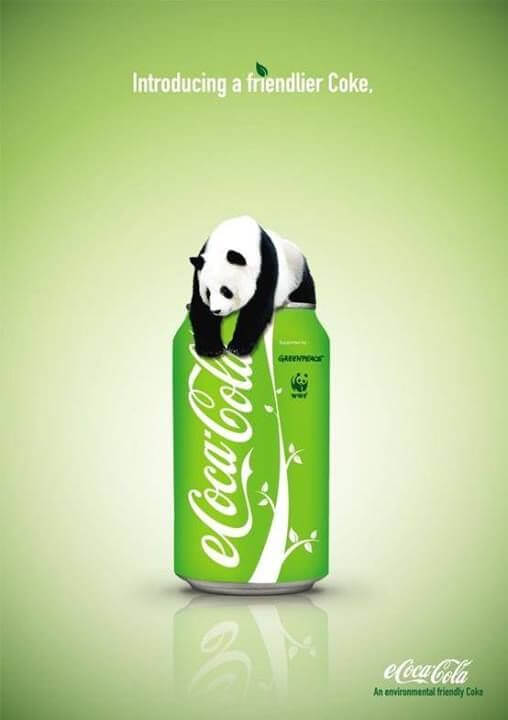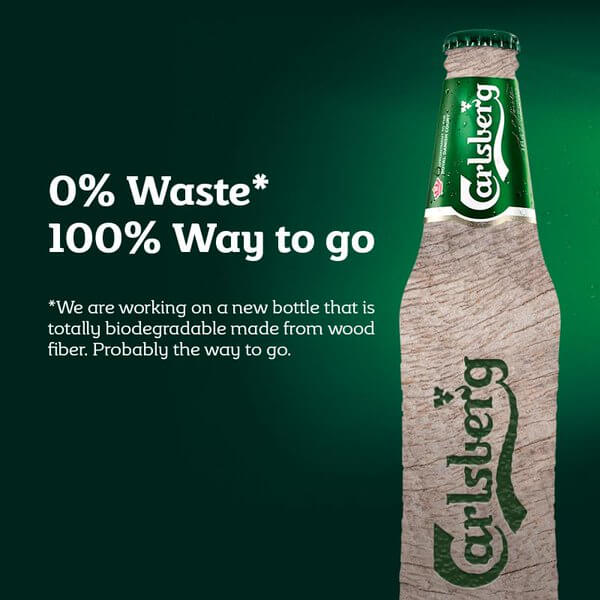Green marketing, it’s time to read the room. Society has never been more concerned with environmental issues.
It goes without saying that our personal opinions should be held separately from our business aims, but as an opportunity, green marketing offers some hefty upsides.
Environmental issues are gaining more media exposure than ever, making green marketing a bedrock of many brands modern marketing strategies.
Green issues are a divisive topic, but with their growing importance in the minds of our target consumers, it’s crucial that your brand falls on the sympathetic side of the argument.
Contents
What Green Issues Are Consumers Concerned About?
To understand the impact that green issues are having on consumers, turn on your television, flick on a popular channel and wait for the advertisements.
I’m sure I’m not the only one whose ads are adorned with green marketing messages from brands actively sharing their environmental campaigns.

These ads are targeted to make consumers think that a vote for them is a vote for the environment (which isn’t always the case).
Of all the green issues covered, there are a handful that stand above the rest in coverage and advertising use. These include environmental issues like:
- Plastic pollution
- Deforestation
- Agriculture – particularly meat consumption
- Global warming
- Recycling
- Fair-trade
BTW: I’m not picking favourites, there are many more environmental issues that are worth mentioning.
If your business has an impact on any of these issues, directly or indirectly, it might be time for you to think about adjusting your strategy and opting for some kind of green marketing within your campaigns.
What is Green Marketing?
Green Marketing Definition:
Also known as environmental marketing and eco-marketing, green marketing is the use of environmental and green issues in marketing campaigns to benefit a business’s pursuit of its aims.
For example, a brand that uses recycled material for its packaging might create an advertising campaign around this to boost sales of its product.
(Source)
Green marketing is becoming more common amongst industry leaders and this trend has filtered down to medium and small businesses – who also want to harness the power of green marketing and make a positive impact on the environment.
The Psychological Draw of Green Marketing
Doing something positive for the world is a great thing. I’d encourage anybody to do their bit for the environment – from simple recycling to making small lifestyle changes.
And it’s because of that commonly echoed sentiment, that I’d recommend any brand to take part in some form of green marketing.

The most powerful thing about green marketing isn’t the alignment of a brand with a green issue, it’s the added consumer draw of making a purchase that benefits the environment.
For example, imagine you’re faced with a choice of two products:
- Product A
- Product B
Both of these products have similar benefits and both will cure your need, however, despite Product A costing slightly more, it also feels like there’s a bigger upside to the purchase because its packaging highlights what the brand does for the environment.
Unilever reports that a third of consumers are now buying from brands based on their social and environmental impact, and more than one in five will actively choose brands that are transparent about sustainability efforts in their packaging and marketing.
The green benefits of a product are an additional reason to purchase.
In simple terms, key purchasing decisions like:
- Product benefits
- Branding
- Price point
- Social proof
Have – in some cases – been superseded by green issues.
This psychological draw of green marketing is real. If you don’t believe me, check out the supermarket shelves on your next visit and analyse how it affects the purchasing decisions of those around you.
How to Use Green Marketing
Green marketing starts with a positive change.
But before you do that, you need to know what environmental issues are most important to your target market and where and how this will fit into your marketing campaigns.
A study by Global Web Index in 2018 discovered that…
60% of internet users say they’ll pay more for products that are eco-friendly.
A search on Google Trends reveals that search terms like ‘Recyclable’, ‘Eco friendly’, ‘Plastic free’, ‘Sustainability’ and ‘Zero waste’ have seen a steady increase in the last 5 years, with the highest peaks appearing in April 2021.
As with any campaign, topic or industry, there will always be fast-trending search terms that rise and peak in search terms – offering brands a choice to target established evergreen keywords, (e.g. sustainability) or to aim for those that are growing.
In terms of environmental issues to target in green marketing, the stats vary from source to source, but there are some that regularly sits among the top. These include green issues like:
- Dealing with waste
- Global warming (aka climate change)
- Overpackaging of consumer goods
- Future energy sources (green energy)
- Air pollution
- Natural resource depletion
- Wildlife conservation
- Deforestation
- Emissions
- Poverty
A 2019 study revealed that ‘dealing with waste’ was considered the most important environmental issue facing Great Britain, with 47% of the 20k participants naming it amongst their top 3, global warming (42%) and over-packaging (30%) came in at 2nd and 3rd, respectively.
Green Issues, Marketing and Business
If your business isn’t ‘green’ already, you’ll need to start by giving yourself something to shout about.
In this section, I’ll share some simple tactical policy changes that will make a positive impact on the environment and allow you to use ‘green marketing’ in your campaigns.
There is no business on a dead planet.
David Brower
Before we dive in, know that no matter what product or services you sell, there is always an opportunity to affect a positive green change and harness the power of eco-marketing.
Donate With Every Sale
A donation with every purchase is an easy way for any business to make a positive environmental change.
This simple process works by partnering with green causes and contributing to them every time you make a sale.
A great example of this is a ‘plant a tree with every purchase’ campaign – there are many green partners who offer this opportunity to businesses – with a contribution as little as 0.15c per sale, planting a new tree.

Small donations with every sale can make a big difference to conversions and customer satisfaction – with many consumers feeling like they have also done something for the environment.
Nordgreen, the watch manufacturers, are a great example of this model, offering consumers a choice of donating 2 months of clean water to one person in the Central African Republic, 1 month of education to a child in India or preserving 50 sqm of rain forest in Latin America with every watch sale.
Eco-Friendly Packaging
Single-use plastic is a big environmental issue right now, with many brands and businesses attempting to distance themselves from it.
A simple change in product packaging, allows brands to share their eco-friendly mentality with ‘made from recycled materials’ labels, and the use of such messages in their green marketing materials.
Fortunately for manufacturers, there are many recycled-only packaging companies.
Materials such as cardboard, paper, wood and recyclable plastics should be in every business’s minds right now – especially in an increasingly distanced world that depends on home delivery.
If you’re in eCommerce, it might be time to think about the way you’re packing and sending your products.
Enjoying This? Check out our 19 Best Marketing Books when you’re done!
Power Sources
A change in the energy source of an office or business location might sound like it would have little impact on your consumers, but it could make a big difference to your brand’s perception.
Showing that you’re committed to environmental issues away from product manufacture will strengthen your affiliation with hot topics such as climate change and global warming.

A great example of this is Intel, who consistently meet 100% of their U.S electricity use with renewable power sources – including wind, solar, geothermal and low-impact hydro.
Recycle Your Own Products
When a product has served its purpose and reached the end of its life-cycle, you’d be forgiven for thinking that it should be chucked in the bin. It’s the way we’ve always acted.
New initiatives, encouraged by green focussed government committees, have seen many brands opt to recycle their own products.
There are many ways to do this, for example, Nike shred their old shoes down and reuse the granules for new clothing, sportswear and playground surfaces, whereas Apple refurbishes and resell old products, or strip them down and reuse any part they can.
Offsetting Your Environmental Impact
There are some business processes whose environmental impact cannot be reduced yet – in cases like this brand’s have the opportunity to take action to offset them with external green actions.
This business activity and the green marketing that surrounds it is particularly valuable to brands who have a bad environmental reputation or history.
The most notable use of this green issue is carbon offsetting – with many brands doing their bit to counteract their damage to the environment.

Think of things like planting trees, donating to green campaigns, encouraging employees to travel together and using environmentally friendly distribution companies.
Affiliations & More…
These 5 simple policies are just a handful of examples for your next green marketing campaigns – and as you’d expect, there are many more.
Think of ways that you can reduce your waste, lower your carbon footprint and do your bit to improve the situation of your audience’s biggest environmental concerns. Simple things can make all the difference.
Sustainability is no longer about doing less harm. It’s about doing more good.
Jochen Zeitz, Harley Davidson CEO
You should also be aware of the power of affiliation. Working with businesses who disregard green issues can have a damaging knock on effect on your brand.
Be conscientious with your cash – know where and who you’re spending it with.
Green Marketing and Green Companies
If you’re already backing a green issue or have something in mind from our list of environmental business ideas, your next step is to go about using it in your marketing campaigns.
In this section, we’ll be analysing how you can use these positive changes to increase product pull and help draw your business closer to its goals by the use of green marketing.
In other words, you’re doing good, it’s time to tell people about it.
Product Packaging
One of the most commonly used green marketing plays is to adorn a product’s packaging with green labels, badges and official certifications.
These packaging logos and icons highlight points of separation for many products on the shelf – giving consumers an additional reason to buy their product over the competition.

Think back to our supermarket example and remember this point when you next go out to the shops.
Green logos that highlight things like recycled packaging, donations or partnerships have been proven to have a positive impact on sales.
If you have a physical product or a digital representation, try including an icon or symbol that represents your environmental empathy to harness this form of green marketing.
Find out more about the effect of green in our guide to colour psychology in marketing.
Landing Pages
Green symbols and logos don’t have to be limited to physical products in brick and mortar locations – digital products and sales processes can also benefit from the use of green labels.
If you’re doing anything that benefits the environment, show it on your landing pages. Green symbols are recognisable, will aid conversion and improve your prospect’s opinion of your brand.

Use a green badge that highlights your commitment to environmental issues.
An easy way to do this is to donate to a worthy cause with every sale. Reach out and form partnerships with charity organisations or green companies, and they’ll usually send you a brand pack for your landing pages.
Additions like this will encourage your on-the-fence prospects to make a purchase, and the most avid of them to share their purchase and the donation.
Green has a powerful psychological effect on its viewers, with connotations of nature, organic material and the green ‘go’ light – urging visitors to go ahead and move forward.
Sharing Options
People love to share positive news. In fact, a recent study revealed that one of the biggest reasons that people share news on social media is to spread entertainment and joy.
By affiliation, a messenger of happy news is viewed in a positive light.
BTW: Check out our guide 5 Steps To The Most Shareable Content On The Internet
It’s for this reason that you should always offer your customers the chance to share your positive environmental impact with their audience.

When a customer makes a purchase with your company and you use it to make a direct impact on the environment (e.g. with a donation) you should offer the consumer a chance to share that impact.
A simple way to do that is to send out an email after every purchase, telling the customer about the donation they have just made via your company (e.g. You just planted a tree!) with sharing options and buttons.
Advertising
A change in policy, new partnership or positive environmental impact is worth a small slice of any brand’s advertising budget.
In campaigns like this, the focus should be on creating awareness rather than sales or lead generation.
Try building a positive rapport with your existing customers by targeting them in a custom audience, using a lookalike audience of your existing customers, or creating an event on your website that indicates an intention to buy.

Sharing your positive environmental impact with this form of green marketing can warm prospects to the idea of purchasing from your business, as well as keeping you top-of-mind.
Content
It really goes without saying that you should create and share content about your green impact.
Content marketing is the present and future of marketing, with the best creators commanding huge audiences and attention.
Use content in your green marketing campaigns – write blogs, talk about the environment on podcasts, feature in videos and use PR techniques to get more coverage for your brand in wide-reaching publications.
When you have long-form or high value content like this, use it to make engaging social media content for your audience.
Create stories, updates and make your green marketing causes a regular part of your posting strategy.
Partnerships
Partnering up with a charity or green campaign can have a positive marketing impact for your brand and partners.
Simple tactics like cross-promoting on each other’s social channels, emailing each other’s list and using logos on your landing and sales pages, can make a big difference moving forward.
A ‘green’ partner’s audience will be heavily invested in their causes, and be much more likely to purchase from a brand who is associated with them.
Green Marketing Conclusion
By now, you should know:
- What green marketing is
- The definition of green marketing
- Who green marketing affects most
- The importance of green marketing
- The environmental issues that are most important to consumers
- How your brand can adopt a green positive approach
- What your business can do to use green marketing
As well as a ton of extra stats, examples and facts.
Green marketing is here to stay and it’s only going to grow in importance in the minds of our target customers.
Do something good for the world and tip the balance back in your favour.
Want more of this on a regular basis? Subscribe and comment!
- Author Details





11 Responses
Interesting read. I knew that green marketing was important but i hadn’t thought about it like this before. Thanks.
Thanks Maria – there is certainly a lot to think about with green marketing!
Josh, this is a good article about green marketing. I want to make a start-up that helps people put more green into their business. You have some good ideas here and I am happy that you are sharing some of these important issues with the world. It is very important that everyone looks after the world.
Thank you for drawing more attention to it. I always liked your blog but will be back soon.
Thank you Blessing and good luck with your next business venture.
More green in the world is definitely a good thing!
Great article and great site. Green issues should be taken more seriously, I just wonder if the big businesses will do anything to really help.
Thank you for sharing your thoughts. I agree about many of the green issues in this blog. I would have thought that in 2021 much of this would be resolved by now, but I think it is important that new businesses know about it too.
You have made some really good points there – green issues are very important.
Thank you for the sensible critique about green marketing. I was preparing to do a little research about this.
Love this! thank you!
I found your post really very interesting and really like this idea of green marketing. This issue is really very important and I think business people should also focus on this by avoiding using paper business cards. Instead, of that, we can move to digital business cards which are more effective.
Great suggestion, thank you Mellisa.